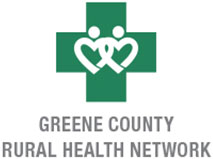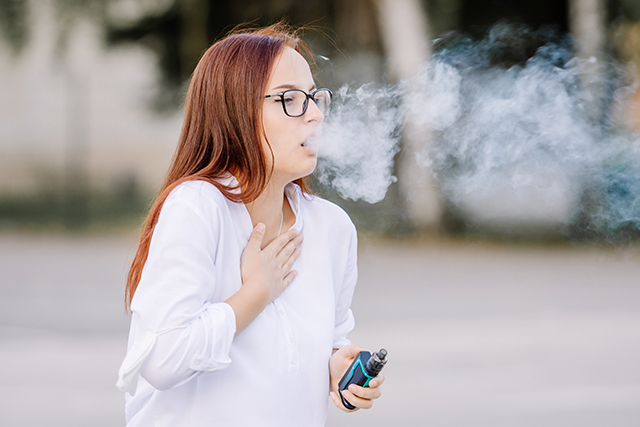Teens & Vaping
What are Electronic cigarettes and how does vaping work?
Electronic cigarettes are battery-powered devices that people use to heat liquid into a vapor that can be inhaled. They’re also called e-cigarettes, e-cigs, or vapes.
The inhaled vapor may contain nicotine (the addictive drug in tobacco), flavorings, and toxins—including ones that cause cancer.
Vaping is the act of inhaling and exhaling the aerosol that is produced by an electronic vapor device when it heats up its liquid ingredients.
Types of E-cigarettes
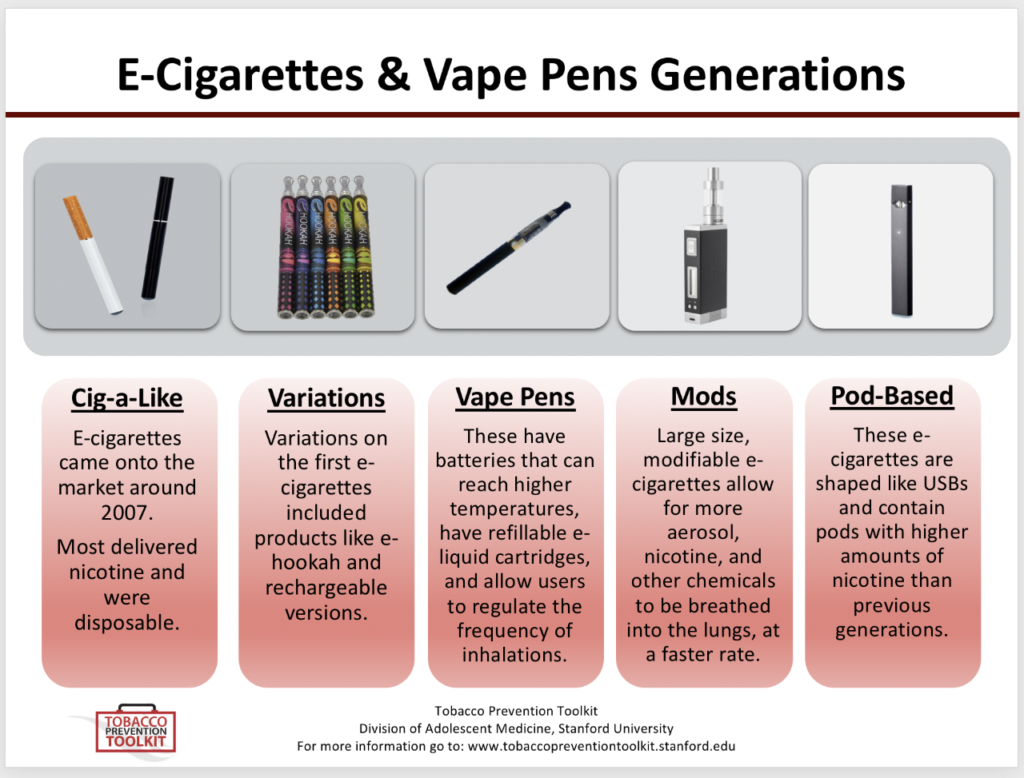
What are teens vaping?
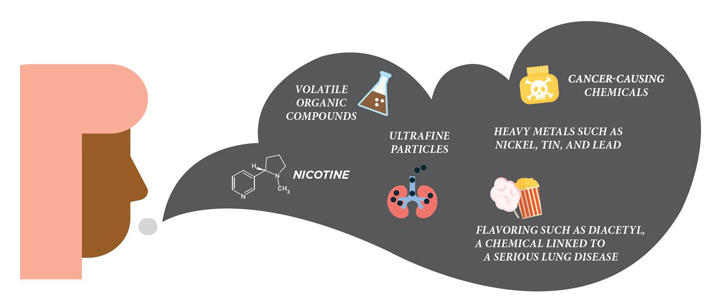
High levels of nicotine
Nicotine is extremely addictive, especially for teens. Nicotine structurally changes the developing brain and can affect attention, learning, mood and impulse control. It can increase blood pressure, respiration, heart rate and can harm the nervous, cardiovascular, respiratory and reproductive system. Addiction risk increases for those with family history or mental health problems.
Thousands of flavorings
Vaping products come in thousands of tasty, unmistakably child-friendly flavors, many with fun and enticing names like Gummy Bear and Cotton Candy. The flavors help mask the harsh taste of nicotine and other chemicals contained in the e-liquid, making it easier to inhale the aerosol. Recent crackdowns on flavors by the federal, state and local governments have begun to shift the landscape of preferred vaping products among youth. Now that flavors, aside from menthol and tobacco, are generally banned in refillable cartridge-based devices like JUUL, loopholes in regulations are driving kids to flavored disposable vapes that have even higher nicotine content and come in countless enticing flavors.[2]
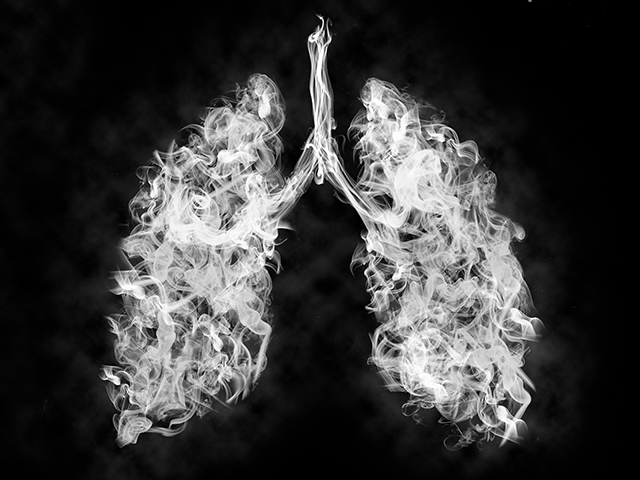 Other chemicals, metals and ultrafine particles
Other chemicals, metals and ultrafine particles
- The aerosol, which many teens believe is harmless water vapor, consists of many chemicals, heavy metals, and fine particles — many of which are toxic and dangerous — that seep deep into the lungs and bloodstream when vaping. Some of the particles found are…
- Volatile organic compounds (VOCs): At certain levels, VOCs can cause eye, nose and throat irritation, headaches and nausea, and can damage the liver, kidney and nervous system.
- Flavoring chemicals: Some flavorings are more toxic than others. Studies have shown that some flavors contain different levels of a chemical called diacetyl that has been linked to a serious lung disease called bronchiolitis obliterans.
- Formaldehyde: This is a cancer-causing substance that may form if e-liquid overheats or not enough liquid is reaching the heating element (known as a “dry-puff”).
Marijuana or other drugs
Increasingly, marijuana ingredients are found in vaping products, including THC — the psychoactive compound in marijuana that creates a sense of being high — the leaf form of marijuana, and CBD. Vapes have also been used to inhale other substances.
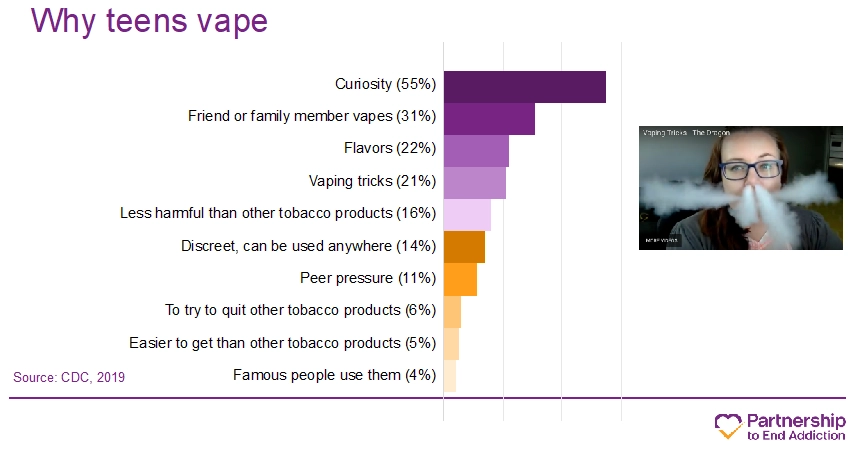
What can parents do?
Know the signs…
- Whiff of a scent of candy, mint, vanilla, cinnamon, etc.
- Pens, flash drives, stylus, pods or cartridges, small bottles of e-liquid
- Thirsty, dry mouth and skin
- Nosebleeds
- Reduced caffeine use
- Glassy eyes
- Behavioral changes
Actions to Take…
- Have conversations – be equipped with the facts, but don’t assume facts will translate into healthy behaviors
- Look for good opportunities to talk – when passing a vape shop, seeing someone vaping, seeing ads for vapes
- Be ready to listen, not lecture – use open-ended questions to get their perspective, such as, “What are your thoughts about vaping?”
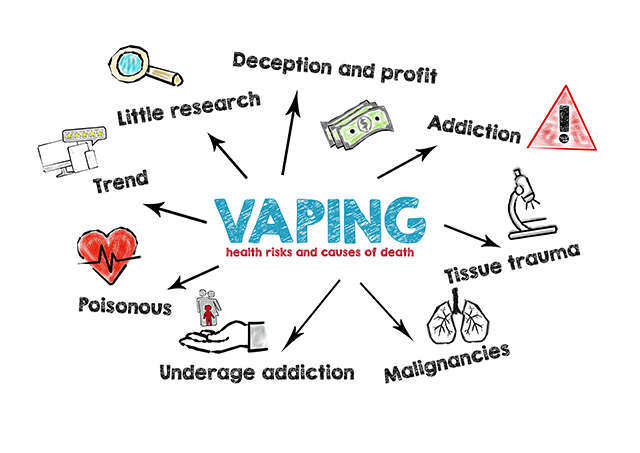
What to say…
- Don’t fall for it – don’t let big businesses take advantage of you, ruin your health, make you dependent
- Don’t be fooled by celebrity and social media promotions
- Don’t contribute to environmental damage
- Make smart and healthy choices – you only have one brain and body, Why mess up your health?
Get Help…
- Addiction is serious, yet 95% of youth with nicotine addiction get no help
- Get professional help if needed – nicotine therapies, Chantix and Wellbutrin may be prescribed by a medical professional (14 yrs old+)
- Consider counseling
- Support for families and teens
- Youth and young adults can access the new e-cigarette quit program by texting “DITCHVAPE” to 88709. Parents and other adults looking to help young people quit should text “QUIT” to (202) 899-7550 (truthinitiative.org)
- Help & hope by text at drugfree.org
- Twin County Recovery Services – 518.943.2036

Sources: Truthinitiative.org, Cancer.org, Cdc.gov, Drugfree.org, Springfield Area Vape Education

